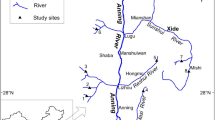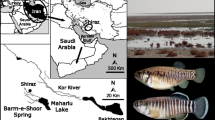Abstract
Feeding behavior and habitat use of the king angelfish, Holacanthus passer, was studied in the southern Sea of Cortés, México. H. passer fed on benthic communities (algae and sessile invertebrates) and in the water column (mainly feces from the damselfish Chromis atrilobata). Although there were not significant differences in feeding rate between sexes, coprophagy was more common in males, while grazing was more common in females. Spatial distribution of size classes followed a pattern of decreasing size with increasing depth. Feeding rate was significantly different among habitats: small females had a higher feeding rate on the bottom, big females and small males had similar feeding rates from the bottom to 3 m above the bottom, and big males had higher feeding rates from 5 m above the bottom to the surface. Habitat was clearly partitioned, and there was significant habitat overlap only between big females and small males. The abundance of H. passer was partly explained (34% of the total variance) by the abundance of the damselfish C. atrilobata. There was a clear trophic association between C. atrilobata schools and H. passer feeding damselfish feces in the water column. The sex ratio male:female of H. passer populations was >1 at several sites, an unusual pattern for a protogynous fish. The sex ratio on the H. passer water column stock was also biased towards males at most sites. Although there is a positive relationship between C. atrilobata abundance and H. passer, there are factors other than damselfish abundance which cause this dominance of males.
Similar content being viewed by others
References cited
Allen, G.R. 1979. Butterfly and angelfishes of the world, vol. 2. Mergus, Melle. 352 pp.
Bailey, T.G. & D.R. Robertson. 1982. Organic and caloric levels of fish feces relative to its consumption by coprophagous reef fishes. Mar. Biol. 69: 45-50.
Bermúdez, A.B. & G. García. 1985. Hábitos alimenticios en los peces de las zonas rocosas de la Bahía de La Paz, B.C.S. Tesis de licenciatura, Universidad Autónoma de México, Mexico D.F. 259 pp.
Brusca, R.C. & D.A. Thomson. 1977. Pulmo reef: the only 'coral reef' in the Gulf of California. Ciencias Marinas 1: 37-53.
Cole, K.S. & D.Y. Shapiro. 1992. Gonadal structure and population characteristics of the protogynous goby Coryphopterus glaucofraenum. Mar. Biol. 113: 1-9.
Dunlap, M. & J.R. Pawlik. 1996. Video-monitored predation by Caribbean reef fishes on an array of mangrove and reef sponges. Mar. Biol. 126: 117-123.
Gerking, S.D. 1994. Feeding ecology of fish. Academic Press, San Diego. 416 pp.
Goldshmid, A. & K. Kotrschal. 1981. Feeding ecology of three populations of Blennius incognitus Bath 1968 (Pisces: Teleostei: Blenniidae) during the reproductive period and under human influence. Mar. Ecol. 2: 1-14.
Harmelin-Vivien, M., C. Chauvet, C. Duval, R. Galzin, P. Lejeune, G. Barnabé, F. Blanc, R. Chevalier, J. Duclere & G. Lassere. 1985. Evaluation visuelle des peuplements et populations de poissons: méthodes et problemes. Rev. Ecol. (Terre Vie) 40: 467-539.
Hiatt, R.W. & D.W. Strasburg. 1960. Ecological relationship of the fish fauna on coral reefs of the Marshall Islands. Ecol. Monogr. 30: 65-127.
Hobson, E.S. 1991. Trophic relationships of fishes specialized to feed on zooplankters above coral reefs. pp. 69-95. In: P.F. Sale (ed.) The Ecology of Fishes on Coral Reefs, Academic Press, San Diego.
Hoffman, S.G. 1983. Sex-related foraging behavior in sequentially hermaphroditic hogfishes (Bodianus spp.). Ecology 64: 798-808.
Hourigan, T.F. & C.D. Kelley. 1985. Histology of the gonads and observations on the social behaviour of the Caribbean angelfish Holacanthus tricolor. Mar. Biol. 88: 311-322.
Hourigan, T.F., F.G. Stanton, P.J. Motta, C.D. Kelley & B. Carlson. 1989. The feeding ecology of three species of Caribbean angelfishes (family Pomacanthidac). Env. Biol. Fish. 24: 105-116.
Jiménez-Illescas, A.R., M. Obeso-Nieblas & D.A. Salas-de León. 1997. Oceanografía física de la Bahía de La Paz, B.C.S. pp. 31-41. In: J. Urbán-Ramírez & M. Ramírez-Rodríguez (ed.) La Bahía de La Paz: Investigación y Conservación
Jones, G.P. 1991. Postrecruitment processes in the ecology of coral reef fish populations: a multifactorial perspective. pp. 294-328. In: P.F. Sale (ed.) The Ecology of Fishes on Coral Reefs, Academic Press, San Diego.
Keast, A. 1978. Trophic and spatial interrelationships in the fish species of an Ontario temperate lake. Env. Biol. Fish. 3: 7-31.
Montgomery, W.L. 1981. Mixed-species schools and the significance of vertical territories of damselfishes. Copeia 1981: 477-481.
Montgomery, W.L. 1980. Marine macroalgae as food for fishes: an evaluation of potential food quality. Env. Biol. Fish. 5: 143-153.
Moyer, J.T. 1984. Reproductive behavior and social organization of the pomacanthid fish Genicanthus Lamarck at Mactan Island, Philippines. Copeia 1984: 194-200.
Moyer, J.T. & A. Nakazono. 1978. Population structure, reproductive behavior and protogynous hermaphroditism in the angelfish Centropyge interruptus at Miyake-jima, Japan. Japan. J. Ichthyol. 25: 25-39.
Moyer, J.T., R.E. Thresher & P.L. Cohn. 1983. Courtship, spawning and inferred social organization of American angelfishes. Env. Biol, Fish. 9: 25-39.
Neudecker, S. & P.S. Lobel. 1982. Mating systems of chaetodontid and pomacanthid fishes at St. Croix. Z. Tierpsychol. 59: 299-318.
Pérez-España, H. & L.A. Abitia-Cárdenas. 1996. Description of the digestive tract and feeding habits of the king angelfish and the Cortes angelfish. J. Fish Biol. 48: 807-817.
Randall, J.E. 1967. Food habits of reef fishes of the West Indies. Stud. trop. Oceanogr. Miami 5: 665-847.
Randall, J.E. & W.D. Hartman. 1968. Sponge feeding fishes of the West Indies. Mar. Biol. 1: 216-225.
Reynolds, W.W. & L.J. Reynolds. 1977. Observations on food habits of the angelfishes, Pomacanthus zonipectus and Holacanthus passer in the Gulf of California. Calif. Fish & Game 63: 124-125.
Robertson, D.R. 1982. Fish feces as fish food on a Pacific coral reef. Mar. Ecol. Prog. Ser. 7: 253-265.
Sala, E. & E. Ballesteros. 1997. Partitioning of space and food resources by three fish of the genus Diplodus (Sparidae) in a Mediterranean rocky infralittoral ecosystem. Mar. Ecol. Prog. Ser. 152: 273-283.
Sale, P.F. (ed.) 1991. The ecology of fishes on coral reefs. Academic Press, San Diego. 754 pp.
Sánchez-Ortiz, C.A., J.L. Arreola-Robles, O. Aburto-Oropeza & M. Cortés-Hernández. 1997. Peces de arrecife en la región de La Paz, B.C.S. pp. 177-188. In: J. Urbán-Ramírez & M. Ramírez-Rodríguez (ed.) La Bahía de La Paz: Investigación y Conservación
Shapiro, D.Y. 1988. Variation of group composition and spatial structure with group size in a sex-changing fish. Anim. Behav. 36: 140-149.
Stevenson, R.A. 1972. Regulation of feeding behavior of the bicolor damselfish (Eupomacentrus partitus Poey) by environmental factors). pp. 278-302. In: H.E. Winn & B.L. Olla (ed.) Behavior of Marine Animals, vol. 2, Plenum Press, New York.
Strand, S.W. 1978. Community structure among reef fish in the Gulf of California: the use of reef space and interspecific foraging associations. Ph.D. Thesis, University of California, Davis. 144 pp.
Thomson, D.A., L.T. Findley & A.N. Kerstitch. 1979. Reef fishes of the Sea of Cortés. Wiley, New York. 302 pp.
Thresher, R.E. 1983. Environmental correlates of the distribution of planktivorous fishes in the One Tree Reef lagoon. Mar. Ecol. Progr. Ser. 10: 137-145.
Thresher, R.E. 1984, Reproduction in reef fishes. TFH Publications, Neptune City. 399 pp.
Williams, D. McB. 1991. Patterns and processes in the distribution of coral reef fishes. pp. 437-474. In: P.F. Sale (ed.) The Ecology of Fishes on Coral Reefs, Academic Press, San Diego.
Author information
Authors and Affiliations
Rights and permissions
About this article
Cite this article
Aburto-Oropeza, O., Sala, E. & Sánchez-Ortiz, C. Feeding Behavior, Habitat Use, and Abundance of the Angelfish Holacanthus passer (Pomacanthidae) in the Southern Sea of Cortés. Environmental Biology of Fishes 57, 435–442 (2000). https://doi.org/10.1023/A:1007606813500
Issue Date:
DOI: https://doi.org/10.1023/A:1007606813500




